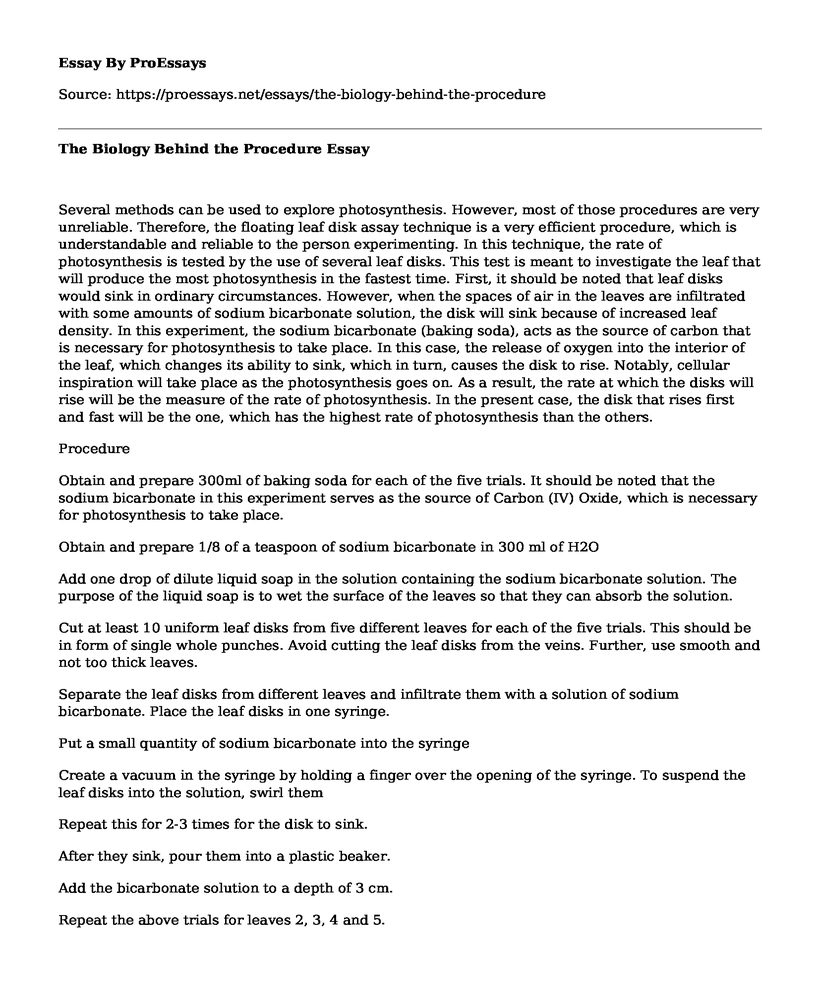Several methods can be used to explore photosynthesis. However, most of those procedures are very unreliable. Therefore, the floating leaf disk assay technique is a very efficient procedure, which is understandable and reliable to the person experimenting. In this technique, the rate of photosynthesis is tested by the use of several leaf disks. This test is meant to investigate the leaf that will produce the most photosynthesis in the fastest time. First, it should be noted that leaf disks would sink in ordinary circumstances. However, when the spaces of air in the leaves are infiltrated with some amounts of sodium bicarbonate solution, the disk will sink because of increased leaf density. In this experiment, the sodium bicarbonate (baking soda), acts as the source of carbon that is necessary for photosynthesis to take place. In this case, the release of oxygen into the interior of the leaf, which changes its ability to sink, which in turn, causes the disk to rise. Notably, cellular inspiration will take place as the photosynthesis goes on. As a result, the rate at which the disks will rise will be the measure of the rate of photosynthesis. In the present case, the disk that rises first and fast will be the one, which has the highest rate of photosynthesis than the others.
Procedure
Obtain and prepare 300ml of baking soda for each of the five trials. It should be noted that the sodium bicarbonate in this experiment serves as the source of Carbon (IV) Oxide, which is necessary for photosynthesis to take place.
Obtain and prepare 1/8 of a teaspoon of sodium bicarbonate in 300 ml of H2O
Add one drop of dilute liquid soap in the solution containing the sodium bicarbonate solution. The purpose of the liquid soap is to wet the surface of the leaves so that they can absorb the solution.
Cut at least 10 uniform leaf disks from five different leaves for each of the five trials. This should be in form of single whole punches. Avoid cutting the leaf disks from the veins. Further, use smooth and not too thick leaves.
Separate the leaf disks from different leaves and infiltrate them with a solution of sodium bicarbonate. Place the leaf disks in one syringe.
Put a small quantity of sodium bicarbonate into the syringe
Create a vacuum in the syringe by holding a finger over the opening of the syringe. To suspend the leaf disks into the solution, swirl them
Repeat this for 2-3 times for the disk to sink.
After they sink, pour them into a plastic beaker.
Add the bicarbonate solution to a depth of 3 cm.
Repeat the above trials for leaves 2, 3, 4 and 5.
Place the beaker containing the leaf disk under a light source and start the timer.
Record down the beaker whose leaf disks will float first.
The beaker whose leaf disks rises first has the highest and fastest rate of photosynthesis.
Materials
Uncertainties
Baking soda 0.455
Liquid soap-0.02
Plastic syringe +0.003ml
Five different leaf materials
Hole punch
Plastic beakers -0.002ml
Timer -0.0005s
A source of light
Variables
Controlled
Bicarbonate solution
Light source
Independent
Plastic syringe
Timer
Hole punch
Dependent
Leaf materials
Liquid soap
Research question
How is the rate at which the leaf disks rises related to the rate of photosynthesis taking place?
References
Google Docs, (2016). Investigating Photosynthesis Lab. [online] Available at: http://www.cherokee.k12.ga.us/departments/curriculum/science/Docs/The%20Floating%20Leaf%20Disk%20Assay%20for%20Investigating%20Photosynthesis.pdf
Cite this page
The Biology Behind the Procedure. (2021, Mar 04). Retrieved from https://proessays.net/essays/the-biology-behind-the-procedure
If you are the original author of this essay and no longer wish to have it published on the ProEssays website, please click below to request its removal:
- Problems of the Male Reproductive System
- Paper Example on Parvocellular Stream and Motion Sensitivity Experiment
- Animal Bushmeat and Ethics Essay
- Essay Sample on Digestive and Respiratory System
- Captive Tigers: An Unsustainable Population in the US - Research Paper
- Essay Example on Seasons: Changing Habits, Climate & Lives
- Paper Example on Sharks & Teleosts: Similarities & Differences







